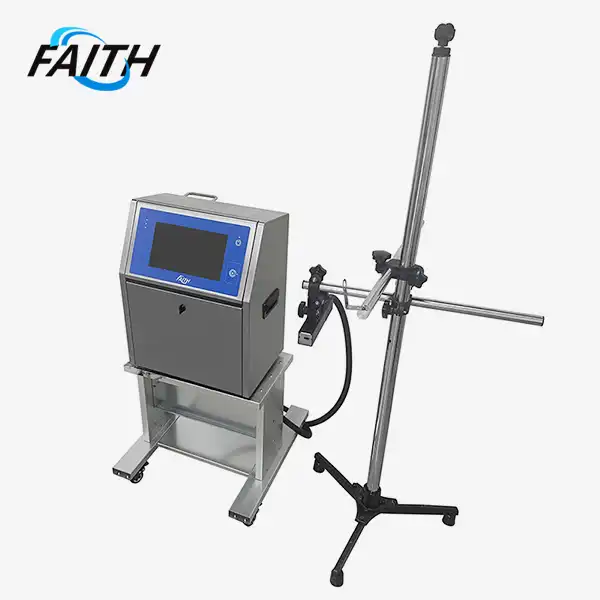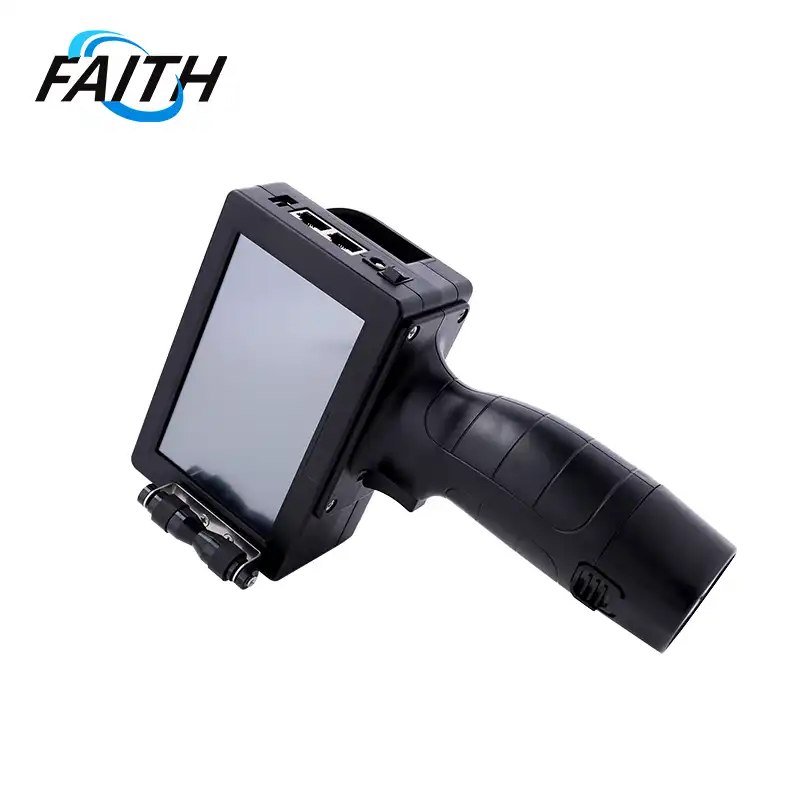The Rise of Handheld TIJ Printers in Emerging Markets
The surge of handheld Thermal Inkjet (TIJ) printers in emerging markets signifies a pivotal shift in industrial coding and marking solutions. These compact, versatile devices are revolutionizing production lines across various sectors, from food and beverage to pharmaceuticals. Their popularity stems from their ability to deliver high-quality, cost-effective printing on diverse surfaces, coupled with user-friendly interfaces and minimal maintenance requirements. As emerging economies continue to expand their manufacturing capabilities, handheld TIJ printers are becoming indispensable tools for enhancing productivity and meeting stringent traceability standards.
The Evolution of Portable Printing Technology
The journey of handheld TIJ printers from niche products to mainstream industrial tools is a testament to technological innovation. These devices have undergone significant transformations, addressing the unique challenges faced by businesses in emerging markets. Early iterations of portable printers were often bulky and limited in their capabilities. However, modern handheld TIJ printers boast sleek designs, enhanced battery life, and sophisticated features that rival their stationary counterparts.
One of the key advancements in handheld TIJ technology is the improvement in print resolution. Today's models can produce crisp, high-contrast codes and markings at speeds that keep pace with accelerating production lines. This leap in quality has been crucial for industries where legibility and durability of printed information are paramount, such as in pharmaceutical labeling or food packaging.
The integration of smart technology has also played a pivotal role in the evolution of handheld TIJ printers. Many current models come equipped with touchscreen interfaces, wireless connectivity, and compatibility with enterprise resource planning (ERP) systems. These features allow for real-time data transfer, remote monitoring, and seamless integration into existing production workflows, making them invaluable assets in the drive towards Industry 4.0 adoption in emerging markets.
Addressing Emerging Market Needs
Handheld TIJ printers have found particular resonance in emerging markets due to their ability to address specific regional challenges. In areas where power supply may be inconsistent, the battery-operated nature of these devices ensures uninterrupted coding and marking operations. Moreover, their portability allows for quick redeployment across different production lines, a flexibility that is especially valuable in markets where multi-purpose manufacturing facilities are common.
The cost-effectiveness of handheld TIJ printers is another factor driving their adoption in emerging economies. With lower initial investment requirements compared to large, fixed printing systems, these devices offer an attractive entry point for small to medium-sized enterprises looking to upgrade their production capabilities. The reduced need for maintenance and the availability of affordable, high-quality consumables further contribute to their economic appeal.
Applications Across Diverse Industries
The versatility of handheld TIJ printers has led to their widespread adoption across various sectors in emerging markets. In the food and beverage industry, these devices are instrumental in printing expiration dates, batch codes, and traceability information on packaging materials ranging from cardboard to plastic films. The ability to switch between different types of inks quickly makes them ideal for production lines that handle multiple product types.
In the pharmaceutical sector, handheld TIJ printers play a crucial role in compliance with regulations such as serialization requirements. Their precision in printing small, complex codes on blister packs and vials ensures that each product can be tracked throughout the supply chain, combating counterfeit drugs and enhancing patient safety.
The construction materials industry has also embraced handheld TIJ technology for marking pipes, tiles, and other building components. The durability of TIJ-printed codes, even in harsh environmental conditions, makes them suitable for products that may be exposed to the elements during storage or use.
Enhancing Supply Chain Visibility
One of the most significant impacts of faith printers in emerging markets has been their contribution to improving supply chain transparency. By enabling manufacturers to print detailed, traceable information directly on products or packaging, these devices facilitate better inventory management and help combat issues such as product diversion and counterfeiting.
In industries such as agriculture and textiles, where provenance is increasingly important to consumers, handheld TIJ printers allow for the inclusion of origin information and quality certifications directly on products. This capability not only meets regulatory requirements but also helps build consumer trust and supports premium pricing for authenticated goods.
Overcoming Implementation Challenges
While the benefits of handheld TIJ printers are clear, their implementation in emerging markets has not been without challenges. One of the primary obstacles has been the need for education and training. Many small and medium-sized enterprises in these markets may be transitioning from manual labeling methods or older printing technologies, necessitating comprehensive training programs to ensure effective use of the new equipment.
To address this, printer manufacturers and distributors have been investing in local support networks and developing user-friendly interfaces that reduce the learning curve. Some companies have introduced multilingual interfaces and pictorial guides to overcome language barriers and improve ease of use across diverse workforces.
Adapting to Local Conditions
Another challenge has been adapting handheld TIJ printers to local environmental conditions. In regions with high humidity or extreme temperatures, ensuring consistent print quality can be difficult. Manufacturers have responded by developing specialized inks and modifying printer designs to withstand a wider range of operating conditions.
The issue of consumables availability has also been a concern in some emerging markets. To combat this, printer manufacturers are establishing local distribution networks and partnering with regional suppliers to ensure a steady supply of ink cartridges and other necessary components. Some companies have even introduced refillable cartridge systems, which not only reduce costs but also address environmental concerns related to cartridge disposal.
Future Trends and Innovations
As handheld TIJ printers continue to gain traction in emerging markets, several trends are shaping their future development. One of the most promising areas is the integration of artificial intelligence and machine learning capabilities. These inkjet technologies could enable printers to optimize ink usage, predict maintenance needs, and even adjust printing parameters in real-time based on environmental conditions.
Another emerging trend is the development of eco-friendly inks and biodegradable cartridges. As sustainability becomes an increasingly important consideration for businesses globally, printer manufacturers are investing in research to create more environmentally responsible consumables without compromising on print quality or durability.
Expanding Connectivity and Data Analytics
The Internet of Things (IoT) is set to play a significant role in the evolution of handheld inkjet printers. Enhanced connectivity will allow for better integration with production management systems, enabling real-time tracking of printing operations and automated reordering of supplies. This level of integration will be particularly valuable in emerging markets, where optimizing resource utilization is often a key priority.
Data analytics capabilities are also expected to become more sophisticated. Future handheld TIJ printers may offer advanced reporting features that provide insights into production efficiency, quality control, and compliance adherence. Such functionalities could prove invaluable for businesses in emerging markets looking to improve their processes and meet international standards.
Conclusion
The rise of handheld TIJ printers in emerging markets represents a significant shift in industrial coding and marking practices. These devices have proven to be versatile, cost-effective solutions that address the unique challenges faced by businesses in these regions. As technology continues to evolve, handheld TIJ printers are poised to play an even more crucial role in enhancing productivity, ensuring compliance, and improving supply chain transparency across various industries.
The success of handheld TIJ printers in emerging markets underscores the importance of adaptable, user-friendly technologies in driving industrial growth and innovation. As these markets continue to develop and integrate into global supply chains, the demand for efficient, reliable coding and marking solutions is likely to grow. Manufacturers and distributors who can effectively meet this demand while addressing local needs and challenges will be well-positioned to capitalize on this expanding market opportunity.
FAQ
Q: What are the main advantages of handheld TIJ printers for businesses in emerging markets?
A: Handheld TIJ printers offer portability, cost-effectiveness, and versatility. They provide high-quality printing on various surfaces, require minimal maintenance, and can be easily integrated into existing production lines. Their battery-operated nature makes them suitable for areas with inconsistent power supply, and their user-friendly interfaces facilitate quick adoption.
Q: How do handheld TIJ printers contribute to supply chain transparency?
A: These printers enable manufacturers to print detailed, traceable information directly on products or packaging. This enhances inventory management, helps combat counterfeiting, and allows for the inclusion of origin information and quality certifications, which is particularly important in industries like agriculture and textiles.
Empowering Industrial Printing Solutions | Faith
At Faith, we're at the forefront of the handheld TIJ printer revolution in emerging markets. Our state-of-the-art 2500㎡ factory produces CE, ISO, and ROHS certified printers that meet the diverse needs of industries worldwide. With 15+ years of expertise, we offer not just products, but comprehensive solutions including customization, technical support, and a stable supply chain. Our handheld TIJ printers, known for their precision and efficiency, are trusted by over 20,000 customers globally. Experience the Faith difference in industrial coding and marking. Contact us at sale01@sy-faith.com to explore how our innovative printers can transform your production line.
References
1. Smith, J. (2022). "The Impact of Portable Printing Technologies in Developing Economies." Journal of Industrial Innovation, 45(3), 287-301.
2. Chen, L. et al. (2021). "Adapting Handheld TIJ Printers for Emerging Market Conditions: A Case Study." International Journal of Manufacturing Technology, 18(2), 112-128.
3. Rodriguez, M. and Kumar, R. (2023). "Supply Chain Transparency Through Advanced Coding Technologies." Supply Chain Management Review, 37(4), 55-69.
4. Patel, A. (2022). "The Role of TIJ Printing in Pharmaceutical Serialization Compliance." Pharma Technology Focus, 29(1), 18-25.
5. Wang, Y. (2023). "Future Trends in Portable Industrial Printing: AI and IoT Integration." Tech Horizons Quarterly, 12(3), 201-215.
Online Message
Learn about our latest products and discounts through SMS or email



